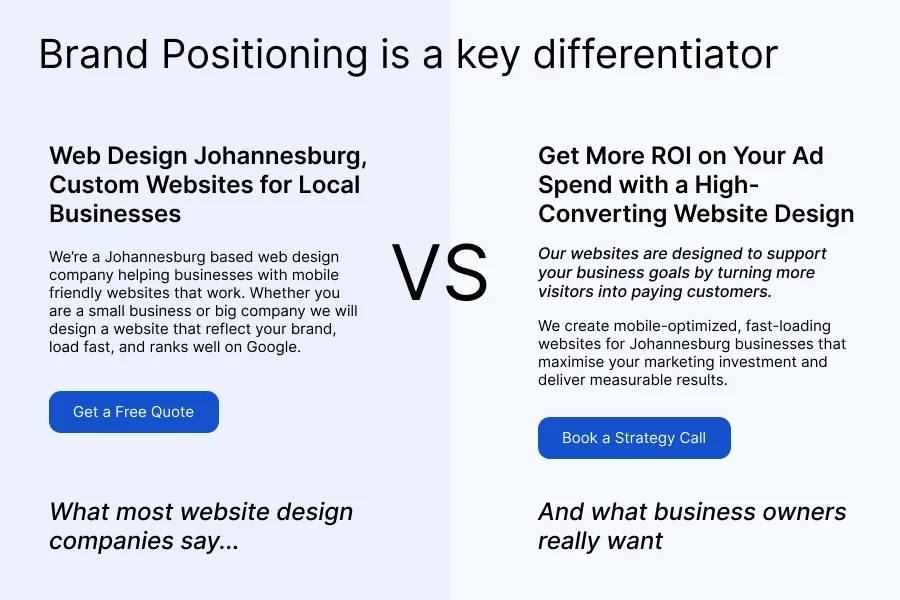Trying to figure out how much you need to invest in a website in South Africa?
The answer isn’t as straightforward as you might expect, and that’s actually a good thing.
According to New Perspective Design, “prices can start as low as R500 for a very basic design and go up to R50,000 or more for complex, custom-built websites with extensive features.”
Similarly, Web Partner estimates “custom website design cost in South Africa can range anywhere between R500 to R50 000. Ultimately, the cost of a website largely depends on two factors – what you need and who you’re getting it from.”
Bunny Pants says “a small business website could cost you as little as ZAR15,000 or as much as ZAR150,000, with complex custom websites reaching up to ZAR1,425,000 or beyond.”
And according to one of South Africa’s leading bid platforms Procompare, “The cost of a business website typically runs from R7500 to R20,000, averaging at R14,000.”
Now here’s the thing, these aren’t conflicting estimates. They are actually reflecting something much more important: different businesses have fundamentally different website needs and value different outcomes.
The business owner who sees their website as foundational capital for growth, the solid foundation to build successful digital marketing strategies on, will gladly invest R15,000+ for strategic website design that delivers measurable results.
Meanwhile, the entrepreneur who simply needs an online presence to establish credibility might find a R1500 basic website design solution perfectly adequate for their goals.
The real question isn’t “How much does a website cost?”, it’s “How much value do you need your website to create for your business?”
Let’s dive into website design cost in South Africa beyond package pricing and explore how to match your investment to your actual business objectives.
Brand Positioning, a Crucial Deciding Factor

As a web designer your brand positioning determines whether you’ll attract R500 clients or R50,000 clients, and there’s nothing wrong with either approach.
For a business owner, where you position yourself among your competitors will determine whether a R2,500 website makes more sense or a R25,000 investment is what you actually need.
Look at how the companies we quoted earlier position themselves. Bunny Pants targets established businesses with their higher price points and emphasis on “complex custom websites.” Their messaging signals they work with clients who have significant budgets and sophisticated needs.
Meanwhile, Web Partner and New Perspective Design cast a wider net with their R500 starting points, appealing to entrepreneurs in the early stages of building their online presence.
This positioning directly impacts what clients expect from you and what they’re willing to pay.
If you’re a business owner with a six-figure operation, you’re not just looking for someone to build a website, you are seeking a strategic partner. When you say “I want to double my service enquiries,” you expect a solution backed by data-driven strategy, not just prettier graphics. You’re willing to invest R15,000+ because you understand that your website is foundational capital for growth.
For web designers, this means positioning yourself as “strategy first, always” if you want to attract high-value clients. During discovery sessions, you do not lead with design features or SEO tactics, you talk business goals. You focus on taking clients from where they are now to where they want to be.
This strategic positioning is what separates a R1500 web design service provider from a +R50,000 digital strategist. Both serve legitimate market needs, but they require completely different approaches to deliver value.
So where does this leave you as a business owner trying to budget for your website?
Think Value, Not the Cost

Have you ever thought about why you find it so easy to subscribe to Showmax or Spotify? These services don’t sell you music or movies, they sell you the value they bring.
Not so long ago, watching a movie meant going to the cinema or buying a DVD that could get scratched and become useless.
For music, you’d buy CDs that would skip right at your favorite song.
Now, with a R99 Showmax subscription, all those DVD player problems are history.
With Spotify, you’re accessing playlists with months of playtime – imagine what you would’ve spent on CDs for that much music.
That’s the power of focusing on value over cost.
Yet here’s what I find fascinating. Since, I offer a recurring website design, during 90% of my sales calls, the first question is “How long do I pay the monthly fee?”
Think about that for a moment.
For something so critical to your business growth, the immediate concern is cost, not value.
You wouldn’t ask Spotify “How long until I own these songs?” because you understand the ongoing value.
But when it comes to your website, your most powerful marketing weapon, the focus shifts to minimising expense rather than maximising return.
The Discovery Call Disconnect

Here’s another telling pattern I’ve observed, about 60% of business owners do design research before discovery calls, preparing to discuss colours, layouts, and visual ideas.
But that’s not what discovery calls are about.
A proper discovery call focuses on understanding your business, goals and target audience. From there, a strategic design company drafts a proposal showing how they will take you from where you are to where you want to be. Only after you agree on objectives, budgets, and timelines do you move to the creative phase where design ideas come into play.
This process differs dramatically between a R2,500 website provider and a +R30,000 web design agency.
The budget provider is likely to discuss design elements during discovery because they want to impress you with creative skills and secure a deposit immediately. Their process is streamlined for quick turnaround.
The higher-investment agency has systems built to be flexible enough to adapt to different business needs. They prioritise understanding before creating, because they’re focused on delivering measurable ROI on your website investment.
Neither approach is wrong, they just serve different market needs.
But understanding this difference is crucial when planning your website around your business goals and determining what’s realistic budget-wise to achieve those goals.
95% of Web Designers in South Africa Compete on Price. That’s a Problem
Only a small percentage of web designers in South Africa charge premium rates for their services. Why? Because they’ve invested in strategic brand positioning that clearly communicates their value to six-figure business owners. This positioning allows them to attract top-tier talent and deliver exceptional results that justify their rates.
The majority of web designers, however, find themselves in a different situation. While they serve their respective clientele well, they’re constantly moving from project to project just to break even. That’s the difference between productive teams and busy teams – one focuses on value creation, the other on volume.
The Content Problem
Search “website design prices in South Africa” on Google and you’ll find the same pattern repeated across dozens of articles: “Website design prices range from R500 to R50,000” followed by generic factors that contribute to cost, tiered pricing packages, and feature comparisons.
What’s missing? Any discussion of process, approach, or how to actually deliver measurable value.
This content sameness exists because it’s easier to confuse potential clients with web design jargon to justify a price than to justify that price with proven, measurable results.
When your competitive advantage is being cheaper than the next provider, you can’t afford to educate clients about what truly drives value.
The Real Cost of Price Competition
This race to the bottom hurts everyone involved.
Business owners struggle to understand what they’re actually buying and web designers find themselves trapped in unsustainable pricing models.
The R1500 website provider can’t invest in the systems and talent needed to deliver strategic value, while clients paying premium rates elsewhere wonder if they’re being overcharged.
The solution isn’t more price transparency. It’s value clarity.
Making the Right Investment Decision

So how do you navigate this landscape and make the right website investment for your business?
First, be honest about your positioning and goals.
If you’re a service-based business looking to generate consistent leads and grow your client base, don’t look at your website as just an expense, it’s your most important marketing asset. In this case, investing R15,000-R30,000 for strategic design and ongoing optimisation makes perfect sense.
By the way, we offer a web design solution that’s built for service businesses. It’s value is not it’s affordability, but the fact that we guarantee to get you 5+ leads every month. Learn more here to see if it’s the kind of web design service that you want.
If you’re a startup testing a business concept or need a simple online presence for credibility, a R1,500-R5,000 solution might be exactly what you need right now. The key is matching your investment to your current business phase and objectives.
Second, evaluate providers based on outcomes, not features. Don’t get caught up in technical jargon or long lists of included features. Ask instead: “What measurable results do your clients see? How do you ensure my website generates leads and grows my business?”
Finally, consider the total cost of ownership. A R1500 website that generates no enquiries is more expensive than a R299pm website design that brings in R50,000 worth of new business annually.
The real question isn’t whether you can afford to invest in a strategic website, it’s whether you can afford not to.
Ready for a Website That Actually Generates Leads?
Most pay monthly web design offers give you a digital brochure collecting dust.
We’re different.
Our Pay Monthly Web Design Packages Deliver:
- Professional, SEO-optimized websites starting at R299/month
- Guaranteed 5+ new client enquiries every month (after 90-day ramp-up)
- Ongoing support, updates, and optimisation
- Real results that pay for themselves
How Most Pay Monthly Web Design Services Fail:
You get an uninspired template website with “free” extras like domain hosting and basic SEO setup.
But if your website isn’t getting you business enquiries, what are you really paying for each month?
What Our Clients Get Instead:
Enquiries landing in their inbox. Real people looking for their services. A website that becomes their best sales tool.
That’s what happens when you focus on value over cost.
Small business website design that work as hard as you do. Guaranteed results. No long-term contracts.
Frequently Asked Questions: Website Design Costs in South Africa
Technical Development Questions
What’s the difference between front-end and back-end development costs?
Front-end development focuses on what users see and interact with – the visual design, layout, and user experience. In South Africa, front-end development typically costs between R8,000-R25,000 for small business websites, depending on complexity and custom animations.
Back-end development handles the server-side functionality – databases, user authentication, content management systems, and integrations. This is more complex and usually costs R15,000-R60,000 for custom solutions. However, many small businesses can use existing CMS platforms like WordPress, which significantly reduces back-end costs.
The key is understanding what your business actually needs. A service-based business might need minimal back-end complexity, while an e-commerce store requires sophisticated database management and payment processing.
How much should I budget for hosting and maintenance annually in South Africa?
Web hosting costs:
- Budget-friendly Shared Hosting Plans: R948-R6468 per year
Suitable for simple websites with low traffic - Dedicated Hosting Plans: R14760 – R72,000 per year
Better performance and reliability
Most web hosting providers include:
- Free SSL certificates
- Daily backups
- High-performance servers, CDN integration
- Enterprise-level security and support
Maintenance Costs:
- Basic updates and security: R3,000-R8,000 annually
- Content updates and SEO optimization: R10,000-R30,000 annually
- Full technical management: R15,000-R50,000 annually
Remember, website maintenance protects your investment, ensures safety for visitors and your website continues generating results.
What’s included in UI/UX design pricing?
Discovery Phase (R3,000-R8,000):
- User research and competitor analysis
- Brand guidelines and style direction
- Wireframing and site architecture planning
Design Phase (R8,000-R35,000):
- Custom visual design for all page templates
- Mobile-responsive design layouts
- Interactive prototypes for complex functionality
Testing Phase (R2,000-R8,000):
- User testing and feedback incorporation
- Cross-browser compatibility testing
- Performance optimization
Higher-end agencies include strategic consultation in their UI/UX pricing, focusing on conversion optimisation and user journey mapping.
This is where the investment pays off – strategic design can increase conversion rates by 200-400%.
How long does custom website development take in South Africa?
Simple Business Websites (5-10 pages): 1-2 weeks
- Basic brochure site with contact forms
- Using existing themes with customisation
- Cost: R1,500-R15,000
Custom Business Website: 2-4 weeks
- Fully custom design and development
- Advanced functionality and integrations
- Cost: R6,000-R50,000+
E-commerce Website: 4-12 weeks
- Custom shopping cart and payment integration
- Product catalog management
- Inventory and order management systems
- Cost: R25,000-R100,000+
Complex Web Applications: 3-12 months
- Custom functionality and databases
- Third-party integrations
- Advanced user management systems
- Cost: R100,000-R500,000+
Timeline delays often occur when clients aren’t prepared with content, branding materials, or clear requirements. Proper planning in the discovery phase prevents costly delays.
Strategic Investment Questions
When does a R15,000 website make more sense than a R500 template?
The decision point isn’t about budget, it’s about business goals and positioning.
Choose R500-R2,000 templates when:
- You’re testing a business concept
- You need basic online presence for credibility
- Your customers don’t research online before buying
- You’re not competing on professionalism or trust
- You have internal resources to manage updates
Invest R15,000-R50,000 when:
- Your website needs to generate leads consistently
- You’re competing against established businesses
- Your customers compare options online before deciding
- Professional credibility directly impacts sales
- You want to scale your marketing efforts effectively
The ROI calculation is simple: If a R25,000 website generates just 2-3 additional clients worth R10,000 each annually, it pays for itself.
A R2500 basic website that generates zero leads is infinitely more expensive.
What ROI should I expect from my website investment?
Service-Based Businesses:
- Well-designed websites typically generate 5-15 qualified leads monthly
- If your average client value is R5,000, that’s R25,000-R75,000 monthly potential
- A R25,000 website investment should pay for itself within 1-3 months
E-commerce Businesses:
- Professional e-commerce sites see 2-5% conversion rates
- 1,000 monthly visitors at 3% conversion = 30 sales
- If average order value is R500, that’s R15,000 monthly revenue
B2B Professional Services:
- High-value service providers often need just 1-2 new clients monthly
- If your services are worth R50,000+ annually per client
- Even a R100,000 website investment creates positive ROI quickly
The key is tracking performance and optimising based on data, not hoping the website “works.”
Should I choose monthly payments or one-time website costs?
Monthly Payments Make Sense When:
- You need ongoing lead generation (not just a brochure)
- You want continuous optimization and updates
- Your cash flow is limited initially
- You prefer predictable monthly expenses
- The provider guarantees specific results
One-Time Payments Are Better When:
- You have sufficient upfront capital
- You need basic online presence without ongoing optimisation
- You have internal resources for maintenance
- You prefer owning your assets outright
- You’re working with agencies focused on project delivery rather than results
Our recommendation: For businesses serious about growth, monthly payment models with guaranteed results often deliver better ROI because they align the provider’s incentives with your success.
Process and Timeline Questions
What happens during the discovery phase of website development?
Business Analysis (Week 1):
- Current situation assessment and competitor research
- Target audience identification and user journey mapping
- Business goals and success metrics definition
- Content audit and gap analysis
Technical Planning (Week 1-2):
- Platform and technology stack selection
- Third-party integrations requirements
- Hosting and performance requirements
- SEO and marketing strategy foundation
Design Strategy (Week 2):
- Brand guidelines and visual direction
- User experience and conversion optimisation planning
- Mobile responsiveness and accessibility requirements
- Content strategy and information architecture
Project Planning (Week 2):
- Timeline and milestone definition
- Resource allocation and team assignments
- Communication protocols and approval processes
- Risk assessment and contingency planning
Investment insight: Agencies that rush or skip discovery typically deliver websites that look good but don’t generate results. Proper discovery adds 2-4 weeks to timelines but increases success probability by 300-500%.
When should I start thinking about SEO and digital marketing costs?
Before Development Starts:
SEO considerations should influence your website’s technical foundation. Building SEO-friendly architecture from the beginning costs significantly less than retrofitting later.
SEO Foundation Costs:
- Technical SEO setup: R5,000-R15,000 (one-time)
- Content optimisation: R8,000-R25,000 (initial)
- Local SEO setup: R3,000-R8,000 (one-time)
Ongoing SEO Investment:
- Content marketing: R5,000-R20,000 monthly
- Link building: R3,000-R15,000 monthly
- Technical maintenance: R2,000-R8,000 monthly
Digital Marketing Budget:
- Google Ads: R5,000-R50,000+ monthly (depends on industry)
- Social media marketing: R3,000-R15,000 monthly
- Email marketing: R1,000-R5,000 monthly
Strategic timing:
Start SEO planning during website development, begin content marketing within 30 days of launch, and consider paid advertising once you have conversion data (usually 60-90 days post-launch).
Cost Optimisation Questions
How can I reduce website development costs without compromising quality?
Smart Cost Reduction Strategies:
Content Preparation:
- Provide all content, images, and branding materials upfront
- Clear requirements documentation prevents scope creep
- Saves 20-40% on development time
Phased Development:
- Launch with core functionality first
- Add advanced features in subsequent phases
- Spreads costs over time while generating revenue sooner
Platform Selection:
- WordPress/CMS solutions vs. fully custom development
- Can reduce costs by 50-70% for standard business sites
- Still allows for custom design and functionality
Template Customisation:
- High-quality premium templates with extensive customisation
- Costs R8,000-R25,000 vs. R25,000-R75,000 for fully custom
- Achieves 80% of custom benefits at 40% of the cost
False Economy Warnings:
- Choosing cheapest hosting (leads to performance issues)
- Skipping mobile optimization (loses 60%+ of traffic)
- Avoiding SEO setup (makes website invisible to search engines)
- No analytics tracking (impossible to measure ROI)
What hidden costs should I watch out for?
Content Creation:
- Professional copywriting: R500-R2,000 per page
- Professional photography: R3,000-R15,000 per shoot
- Stock photography licensing: R200-R1,000 per image
- Video production: R5,000-R50,000 per video
Third-Party Integrations:
- Payment gateway setup: R2,000-R8,000
- CRM integration: R3,000-R15,000
- Email marketing platform connection: R1,000-R5,000
- Analytics and tracking setup: R2,000-R8,000
Legal and Compliance:
- Privacy policy and terms of service: R2,000-R8,000
- POPI compliance setup: R3,000-R12,000
- Accessibility compliance: R5,000-R20,000
- SSL certificates: R500-R3,000 annually
Ongoing Expenses:
Domain registration: R100-R500+ annually
Email hosting: R100-R500 monthly
Backup services: Free-R500+ monthly
Security monitoring: R500-R2,000 monthly
Budget recommendation: Add 20-30% buffer to quoted prices for unexpected requirements and scope adjustments.
Performance and Results Questions
How do I measure my website’s ROI and performance?
- Monthly website visitors and traffic sources
- Conversion rate (visitors to leads)
- Cost per lead acquisition
- Lead quality and sales conversion rates
Business Impact Metrics:
- Monthly revenue attributed to website
- Average customer lifetime value from web leads
- Return on advertising spend (ROAS)
- Market share growth in target keywords
Technical Performance Metrics:
- Page loading speed (should be under 3 seconds)
- Mobile usability scores
- Search engine ranking positions
- Website uptime and availability
Tools for Measurement:
- Google Analytics (free): Traffic and behavior analysis
- Google Search Console (free): SEO performance tracking
- Call tracking software: R500-R2,000 monthly
- CRM integration: Leads to sales conversion tracking
ROI Calculation Formula:
(Website-Generated Revenue – Website Investment) / Website Investment × 100
Example: R25,000 website generates R100,000 additional annual revenue
ROI = (R100,000 – R25,000) / R25,000 × 100 = 300% ROI
What results should I expect in the first 90 days after launch?
Realistic 90-Day Expectations:
Months 1-2: Foundation Building
- Website indexed by search engines
- Local SEO listings established
- Analytics and tracking systems active
- Initial content marketing campaigns launched
Month 3: Early Results
- 5-20% increase in organic search visibility
- 10-50 monthly website visitors (depending on market size)
- 2-8 qualified leads generated
- Improved brand perception and professional credibility
Factors Affecting Results:
- Industry competition level
- Local market size and demand
- Content marketing consistency
- SEO foundation quality
- Paid advertising investment
Red Flags – Call for Review:
- Zero search engine visibility after 60 days
- No lead generation after 90 days
- High bounce rates (>70%) consistently
- Page loading speeds above 5 seconds
Optimization Recommendations: Most websites require 2-3 optimization cycles in the first 6 months to achieve peak performance. Budget R5,000-R15,000 for post-launch optimization based on real user data.
Industry-Specific Questions
How much should specific industries budget for websites in South Africa?
Professional Services (Law, Accounting, Consulting):
- Basic professional presence: R15,000-R35,000
- Lead generation optimized: R35,000-R75,000
- High competition markets: R75,000-R150,000
- Critical success factor: Trust and credibility signals
Healthcare and Medical Practices:
- Basic practice website: R12,000-R25,000
- Patient portal integration: R25,000-R60,000
- Compliance and booking systems: R60,000-R120,000
- Critical success factor: Patient testimonials and credentials
Retail and E-commerce:
- Basic online store: R20,000-R50,000
- Advanced e-commerce platform: R50,000-R150,000
- Multi-vendor marketplace: R150,000-R500,000+
- Critical success factor: User experience and conversion optimization
Construction and Trade Services:
- Portfolio showcase site: R8,000-R20,000
- Lead generation system: R20,000-R45,000
- Project management integration: R45,000-R100,000
- Critical success factor: Before/after galleries and local SEO
Restaurant and Hospitality:
- Basic menu and info site: R5,000-R15,000
- Online ordering system: R15,000-R40,000
- Reservation and event management: R40,000-R80,000
- Critical success factor: Visual appeal and mobile optimisation
Manufacturing and B2B:
- Corporate website: R25,000-R60,000
- Product catalog and specs: R60,000-R120,000
- Customer portal and ordering: R120,000-R300,000
- Critical success factor: Technical specifications and case studies